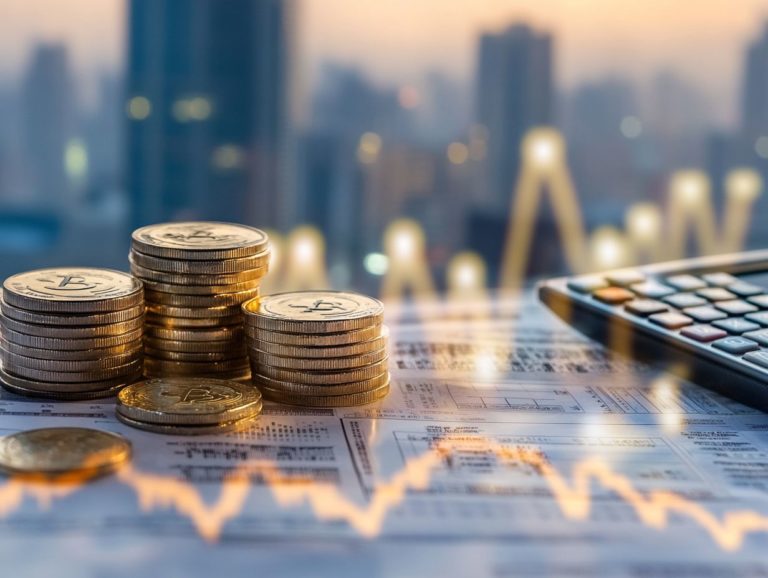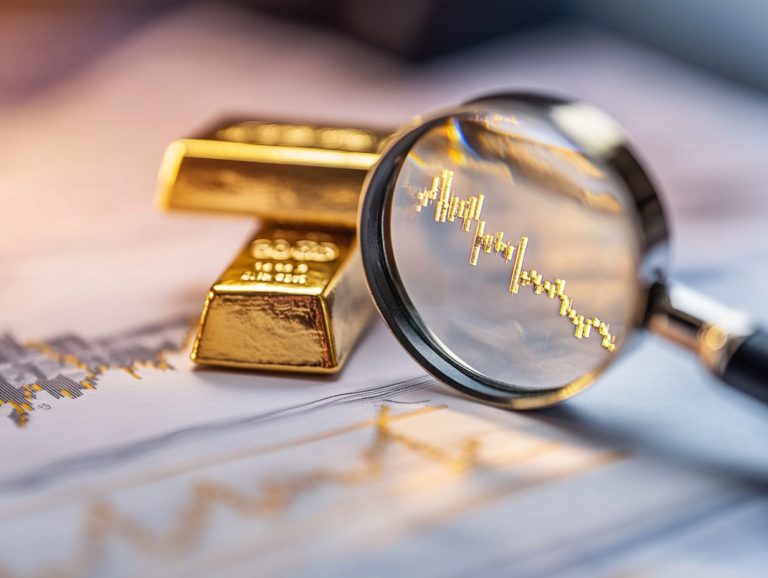How to Identify Fake Gold?
Fake gold is more common than you think. Identifying it among genuine pieces can be a challenge!
This article explores various types of fake gold. From counterfeit coins to gold-plated jewelry, we ll highlight key signs to help you spot the fakes.
We also provide practical tips to prevent you from unintentionally buying fake gold. Learn what to do if you discover you’ve purchased a counterfeit item.
Empower yourself with this knowledge to protect your investments!
Contents
- Key Takeaways:
- Types of Fake Gold
- Signs of Fake Gold
- How to Avoid Buying Fake Gold
- What to Do if You Have Fake Gold
- Frequently Asked Questions
- What are some common signs that a piece of gold may be fake?
- How can I tell if my gold jewelry is fake?
- Is there a way to test the purity of gold without specialized equipment?
- Are there any household items that can be used to identify fake gold?
- Can fake gold have the same markings as real gold?
- Can gold coins be fake?
Key Takeaways:
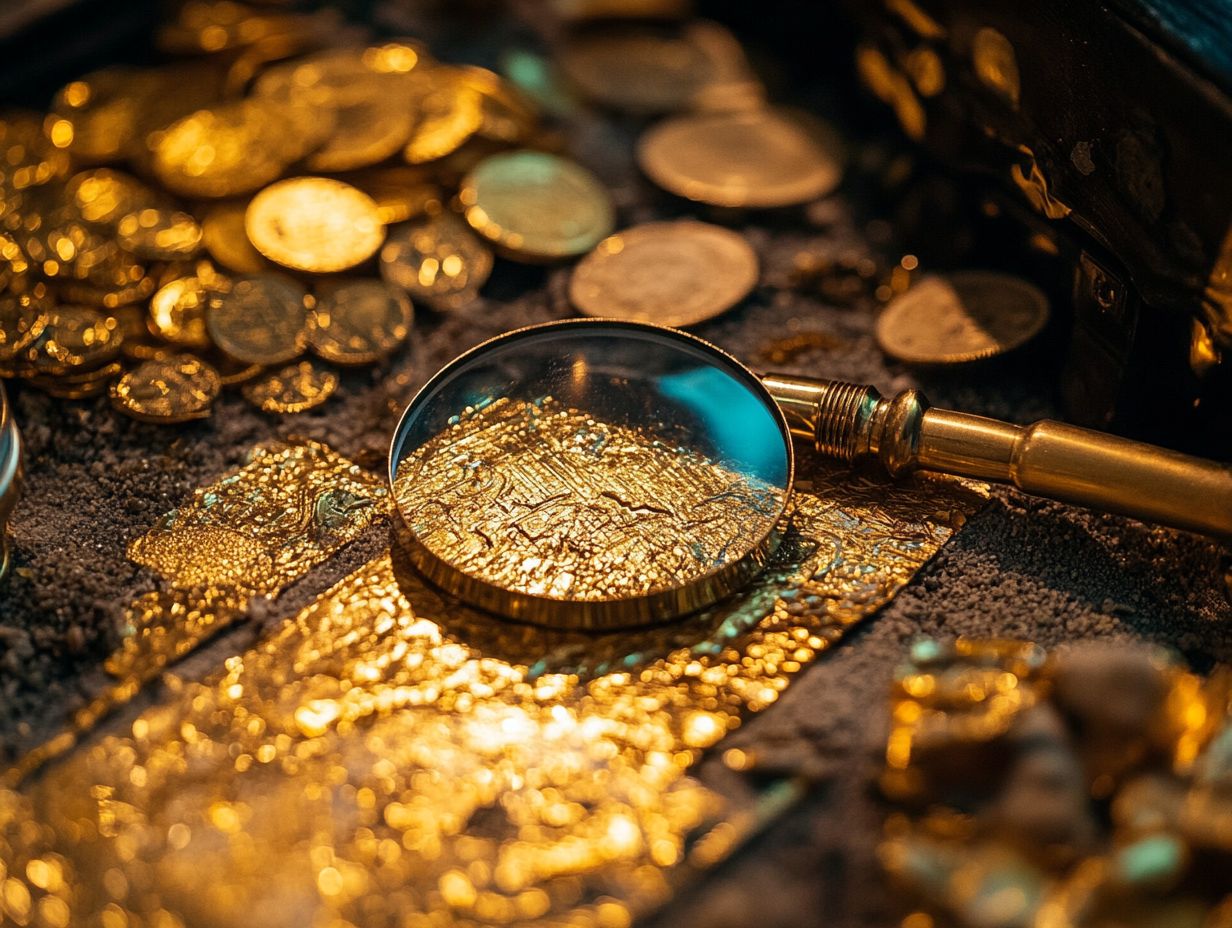
- Check physical traits like weight, color, and markings to spot fake gold.
- Use chemical tests, such as the nitric acid test, to confirm if gold is genuine.
- Avoid buying from untrustworthy sources and always seek a professional opinion.
What is Fake Gold?
Fake gold is any material that looks like real gold but isn t. This includes gold-plated items and counterfeit coins.
The market is full of these misleading alternatives. They often look so convincing that it s hard to tell them apart from real gold.
Genuine gold is valued for its unique properties. These include its malleability, resistance to tarnishing, and the characteristic yellow hue, while fake gold usually tarnishes over time.
Recognizing imitation signs is crucial, especially if you’re looking to make smart purchases. Utilizing gold testing techniques, like acid tests or magnet tests, can help you verify the authenticity of your pieces and protect your investments.
Types of Fake Gold
Be aware of the types of fake gold that exist. This includes counterfeit gold coins and gold-plated jewelry, each with unique challenges.
Local jewelers in Burlington, Vermont, often see these fakes, which can greatly impact the perceived value of jewelry. Knowing the types of fake gold is essential for anyone considering an investment.
Counterfeit Gold Coins
Counterfeit gold coins are imitations that look like real gold coins but often lack the right quality. They may not have the proper gold density or karat markings.
Detecting these fakes can be tough without expert help. That s why it s important to consult a qualified gemologist.
Counterfeit coins are usually made from base metals coated with a thin layer of gold. Techniques like electroplating are often used in this deceptive process.
To tell the difference between real and fake coins, gemologists use methods like acid tests and density checks. Collectors should educate themselves on these methods to avoid falling for counterfeit coins, especially when fakes can look very similar to genuine ones. Additionally, knowing how to sell your gold investments profitably can also enhance their overall value in the market.
Gold-Plated Jewelry
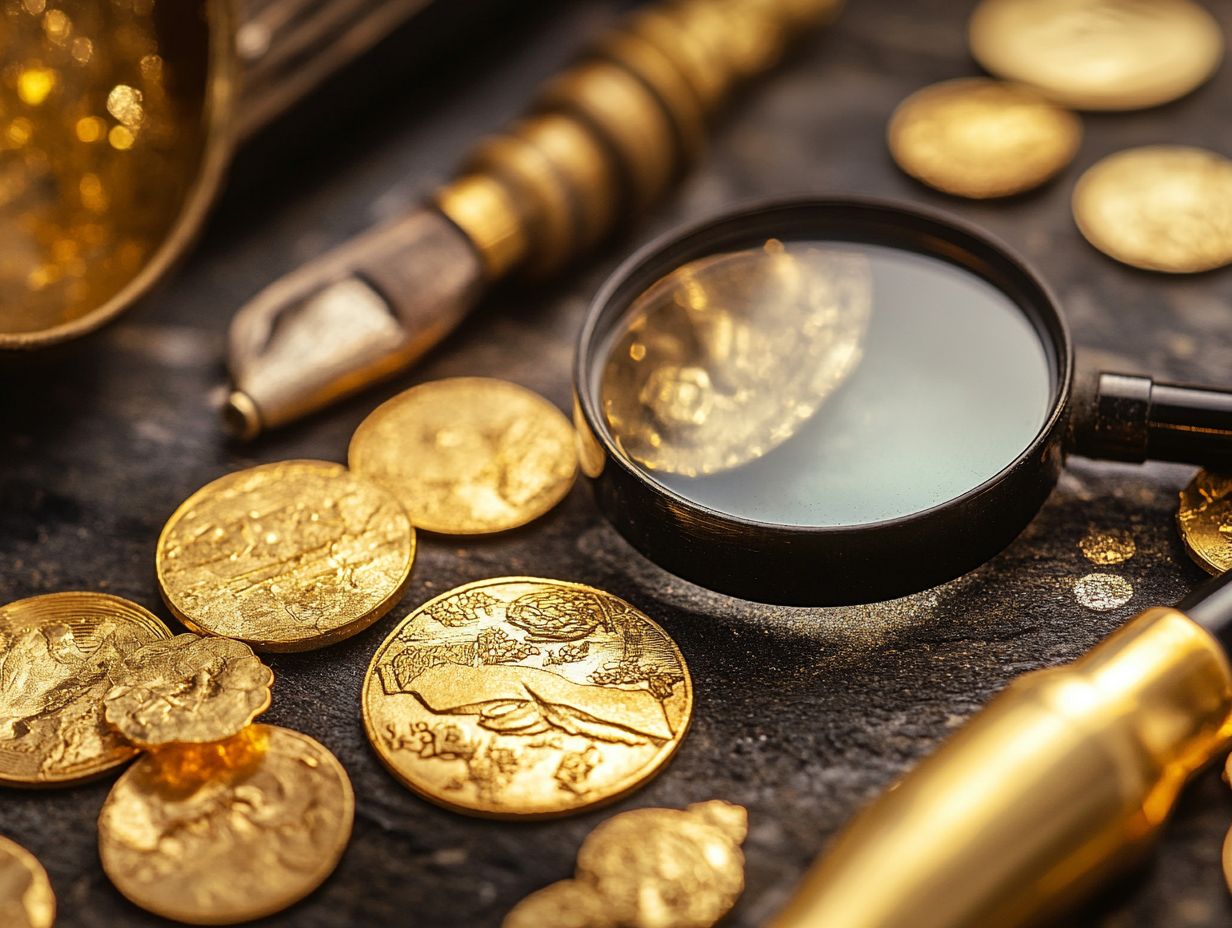
Gold-plated jewelry dazzles with shine but is often mistaken for real gold. In reality, it features a base metal covered with a thin layer of gold.
This makes it a common choice in faux gold items. Unlike genuine gold, which retains its value, gold-plated pieces can lose their luster over time.
Jeweler Kennon Young highlights the importance of understanding gold purity. This knowledge helps you make smart purchasing decisions.
You may not realize that the gold layer on these pieces is typically measured in microns, which are one-millionth of a meter. If the base metal is of inferior quality, it can tarnish quickly, adding to the authenticity dilemma.
This distinction is crucial for those looking to invest wisely in jewelry collections. While solid gold enhances your wardrobe and serves as a dependable investment, gold-plated jewelry warrants more careful consideration and perhaps the insights of a jewelry expert.
Expert guidance can clarify the subtle differences between genuine quality and mere superficial charm, ultimately guiding you toward choices that align with your long-term aspirations.
Signs of Fake Gold
Identifying fake gold demands an astute eye for specific signs. Look for inconsistencies in weight, color, and the markings indicating gold purity.
Be mindful of subtle differences perhaps the absence of proper karat markings or an unexpected texture when you hold it. To guarantee the highest quality in your jewelry, consider employing a dual approach of physical inspection and chemical testing.
Techniques such as fire assay, which involves melting the sample to measure gold content, and nitric acid testing, which evaluates how gold reacts with acids, can effectively unveil authenticity. Together, these methods ensure you make informed decisions.
Physical Characteristics
Physical characteristics are essential in distinguishing real gold from fake. Key aspects include weight, color, and karat markings.
Genuine gold is notably dense and has a distinct feel, while imitations often feel lighter and may vary in hue. For example, 24 karat gold boasts a unique color that differentiates it from lower karat options like 18 or 14 karat gold. Knowing when to buy gold can also enhance your investment choices.
The color of gold can shift depending on its karat rating. For instance, 18 karat gold, mixed with other metals, often appears less vibrant than its pure counterpart. To enhance your investment strategy, learn how to use gold to diversify your portfolio. Familiarize yourself with the hallmarking system, as authentic gold typically carries a specific stamp indicating its karat level.
Conducting an acid test can further scrutinize authenticity, providing you with extra assurance. By recognizing these key indicators, you enhance your chances of acquiring genuine gold and safeguard against potential financial loss.
Chemical Tests
Chemical tests are essential tools for verifying gold authenticity. They offer definitive proof regarding the purity of your gold items.
These methods use various chemical reactions and advanced technology to reveal the true nature of gold samples. For example, fire assay allows for precise separation and measurement of gold content, making it one of the most trustworthy tests.
Nitric acid tests evaluate how gold reacts with strong acids, giving you insight into whether an item is solid gold or just coated with a thin veneer. Advanced techniques like X-ray fluorescence spectrometry allow for quick assessments without damaging the items.
Together, these methods create a robust toolkit that you can depend on to make informed purchases in the gold market.
How to Avoid Buying Fake Gold
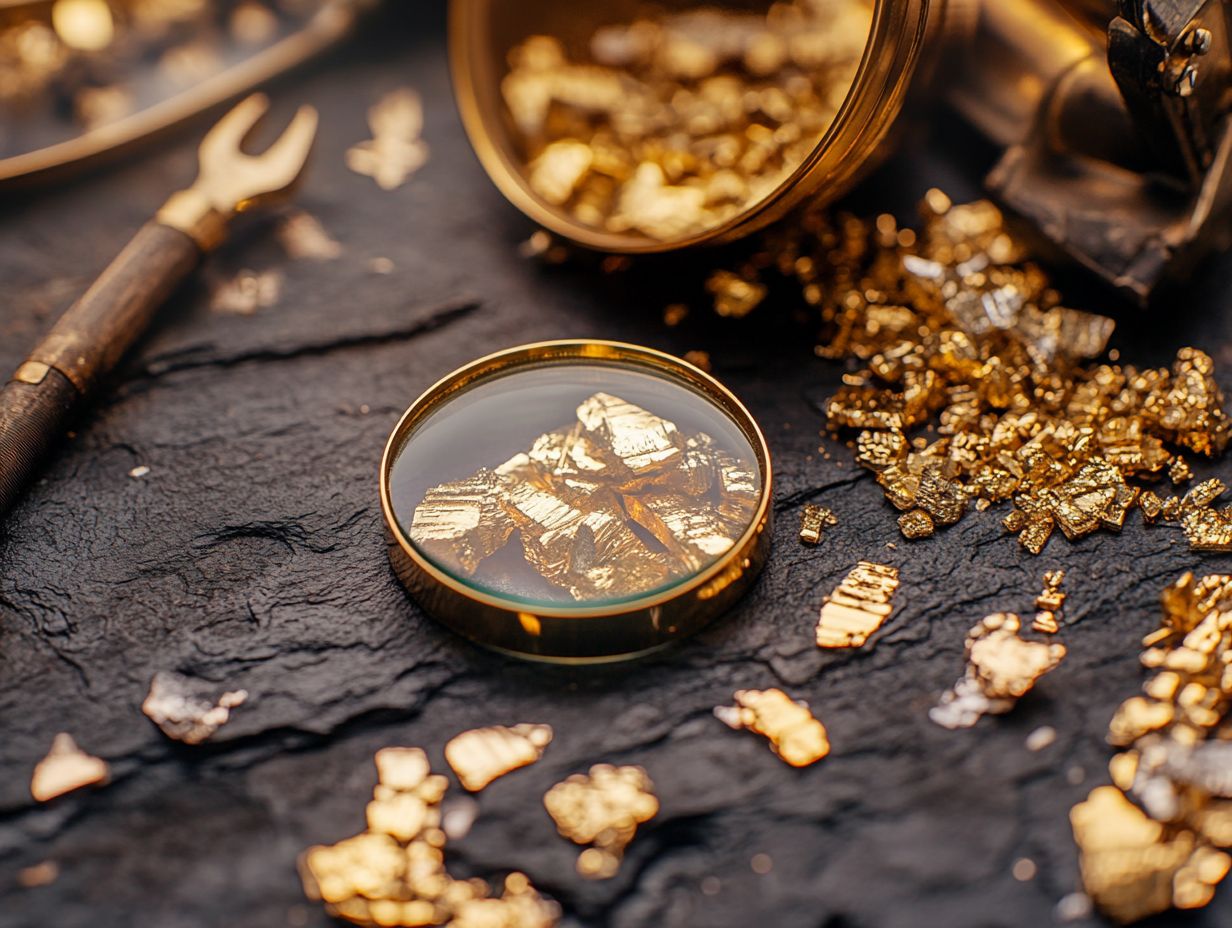
Avoiding the pitfalls of purchasing fake gold demands a keen eye and a solid understanding of gold authenticity. Equip yourself with effective strategies to verify the quality of gold items before committing to a purchase.
Seek out reputable jewelers and request gold appraisals. This ensures that your investment is in genuine gold rather than mere imitations. By understanding the nuances of gold purity and its distinctive characteristics, you can confidently evaluate options like handmade engagement rings and wedding bands. Additionally, consider learning how to protect your gold investments to make informed choices that reflect your discerning taste.
Tips for Identifying and Verifying Authentic Gold
Identifying and verifying authentic gold requires knowledge, experience, and sometimes the expertise of a qualified gemologist. Familiarize yourself with standard gold purity markers and characteristics. Stay vigilant about the common signs of counterfeit gold.
In Burlington, Vermont, local experts often offer valuable insights that can assist you in confirming the authenticity of gold items. This ensures your investment is sound.
Understand the karat system, which measures how pure the gold is. Knowing the distinctions between 10K, 14K, and 24K gold provides vital context for your purchases. To learn more about how to invest in gold, evaluate the weight against the size to find clues about authenticity, since counterfeit pieces often use lighter materials.
You might also want to request official appraisal documentation or a certificate of authenticity. Consulting a gemologist for an expert opinion ensures accurate assessments and enhances your confidence in any gold purchase.
What to Do if You Have Fake Gold
Discovering that you have fake gold? Act fast to protect your investment! Consulting a qualified jeweler for a gold appraisal can clarify the best course of action whether that means returning the item, pursuing a refund, or finding ways to repurpose the jewelry.
Understand your rights as a consumer to navigate this situation effectively and make informed decisions.
Options for Dealing with Fake Gold
You have several effective options for addressing the issue of fake gold. Reach out to the seller for a return or exchange, or consult a knowledgeable jeweler for a thorough gold appraisal and expert guidance.
Document any communication with the seller, as this could prove invaluable if you need to escalate the situation. Before contacting jewelers, check online reviews or local resources to ensure you choose one with a solid reputation.
Engaging consumer protection agencies can provide you with significant support if the seller is uncooperative or if you can’t reach a resolution on your own. Familiarize yourself with the available resources to navigate the complexities of dealing with fake gold effectively transforming a frustrating experience into one that maximizes your value through repair, resale, or gaining valuable insights. Additionally, knowing the best places to buy physical gold can help you make informed purchasing decisions.
Frequently Asked Questions
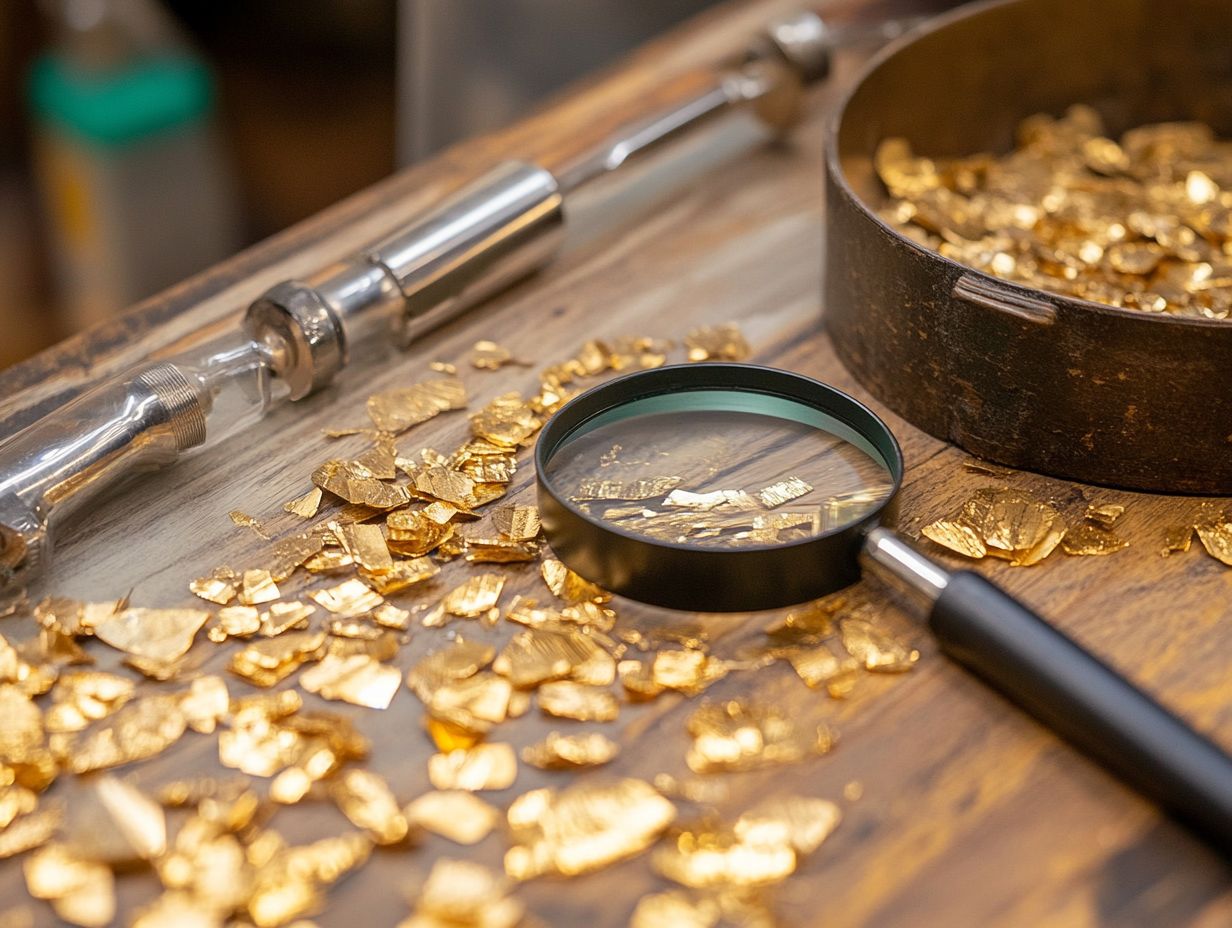
What are some common signs that a piece of gold may be fake?
Common signs of fake gold include discoloration, flaking or chipping, and a lack of weight compared to its size.
How can I tell if my gold jewelry is fake?
You can use a magnet to test the authenticity of your gold jewelry. If it sticks to the magnet, it is likely not real gold.
Is there a way to test the purity of gold without specialized equipment?
Yes, perform a “scratch test” by rubbing the gold against a ceramic plate. If it leaves a black streak, it is not real gold.
Are there any household items that can be used to identify fake gold?
Yes, you can use vinegar or nitric acid to test the authenticity of gold. Real gold will not react to these substances, while fake gold will.
Can fake gold have the same markings as real gold?
Yes, counterfeiters sometimes stamp fake gold to make it look real. However, you can spot the difference by checking its weight and physical features.
Can gold coins be fake?
Yes, gold coins can indeed be counterfeit. Always buy from trusted dealers and use reliable testing methods to confirm their authenticity!










